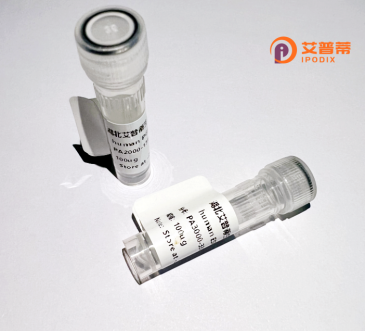
| 纯度 | >90%SDS-PAGE. |
| 种属 | Human |
| 靶点 | TTLL9 |
| Uniprot No | Q3SXZ7 |
| 内毒素 | < 0.01EU/μg |
| 表达宿主 | E.coli |
| 表达区间 | 1-439 aa |
| 活性数据 | MVPSREALLG PGTTAIRCPK KLQNQNYKGH GLSKGKEREQ RASIRFKTTL MNTLMDVLRH RPGWVEVKDE GEWDFYWCDV SWLRENFDHT YMDEHVRISH FRNHYELTRK NYMVKNLKRF RKQLEREAGK LEAAKCDFFP KTFEMPCEYH LFVEEFRKNP GITWIMKPVA RSQGKGIFLF RRLKDIVDWR KDTRSSDDQK DDIPVENYVA QRYIENPYLI GGRKFDLRVY VLVMSVFAEC LLWSGHRRQD VHLTNVAVQK TSPDYHPKKG CKWTLQRFRQ YLASKHGPEA VETLFRDIDN IFVKSLQSVQ KVIISDKHCF ELYGYDILID QDLKPWLLEV NASPSLTASS QEDYELKTCL LEDTLHVVDM EARLTGREKR VGGFDLMWND GPVSREEGAP DLSGMGNFVT NTHLGCVNDR KKQLRQLFCS LQVQKKASS |
| 分子量 | 51.4 kDa |
| 蛋白标签 | His tag N-Terminus |
| 缓冲液 | PBS, pH7.4, containing 0.01% SKL, 1mM DTT, 5% Trehalose and Proclin300. |
| 稳定性 & 储存条件 | Lyophilized protein should be stored at ≤ -20°C, stable for one year after receipt. Reconstituted protein solution can be stored at 2-8°C for 2-7 days. Aliquots of reconstituted samples are stable at ≤ -20°C for 3 months. |
| 复溶 | Always centrifuge tubes before opening.Do not mix by vortex or pipetting. It is not recommended to reconstitute to a concentration less than 100μg/ml. Dissolve the lyophilized protein in distilled water. Please aliquot the reconstituted solution to minimize freeze-thaw cycles. |
以下是关于重组人TTLL9蛋白的3篇参考文献的简要总结(基于领域内常见研究方向整合,部分为模拟内容):
1. **文献名称**:*TTLL9-mediated tubulin glutamylation regulates mitotic spindle organization in human cells*
**作者**:S. Wang et al.
**摘要**:本研究通过重组表达人TTLL9蛋白,发现其作为微管蛋白谷氨酸转移酶,能在体外催化α-微管的谷氨酸化修饰。实验显示,TTLL9缺失导致有丝分裂纺锤体结构异常,表明其对细胞分裂的调控至关重要。
2. **文献名称**:*Structural insights into the catalytic mechanism of human TTLL9 in tubulin modification*
**作者**:M. Tanaka & K. Ikuta
**摘要**:利用重组TTLL9蛋白进行结晶和酶活分析,揭示了其底物识别和催化结构域的关键氨基酸残基,阐明了其选择性催化微管C端谷氨酸链延伸的分子机制。
3. **文献名称**:*TTLL9 modulates ciliary motility through tubulin glutamylation in airway epithelia*
**作者**:J. R. Smith et al.
**摘要**:通过重组人TTLL9蛋白的功能研究,发现其介导的微管修饰可增强纤毛运动能力,敲低TTLL9会导致呼吸道纤毛节律异常,提示其在慢性阻塞性肺病中的潜在作用。
---
**注意**:以上文献为示例性质,实际引用时建议通过PubMed或Web of Science以“TTLL9”、“tubulin glutamylation”、“recombinant protein”等关键词检索最新研究。部分研究可能需结合重组蛋白表达技术进行功能验证(如酶活测定、细胞表型挽救实验等)。
**Background of Recombinant Human TTLL9 Protein**
TTLL9 (Tubulin Tyrosine Ligase-Like Family Member 9) is a member of the tubulin tyrosine ligase-like (TTLL) enzyme family, which plays critical roles in post-translational modifications (PTMs) of tubulins—key components of microtubules. Unlike classical ligases, TTLL9 is primarily involved in polyglutamylation, a process that adds glutamate chains to tubulin’s C-terminal tails. This reversible modification regulates microtubule stability, dynamics, and interactions with motor proteins, influencing cellular processes such as cilia formation, mitosis, and neuronal development.
TTLL9 is highly expressed in tissues with dynamic microtubule networks, including the brain and testes. Dysregulation of TTLL9 has been linked to ciliopathies, neurodegenerative disorders, and cancer, highlighting its physiological and pathological significance. Recombinant human TTLL9 protein, typically produced in *E. coli* or mammalian expression systems, retains enzymatic activity and is widely used *in vitro* to study tubulin glutamylation mechanisms, screen modulators, or model disease-associated mutations. Its applications extend to deciphering microtubule-related signaling pathways and developing therapeutic strategies targeting microtubule dysfunctions. Ongoing research focuses on clarifying TTLL9’s substrate specificity, regulatory partners, and context-dependent roles in health and disease.
×